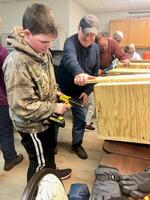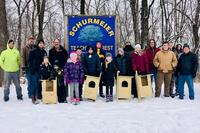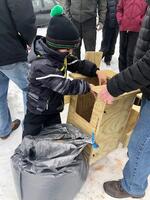Elizabeth, IL- The 4-H “What a Hoot” Owl Club members are taking part in the Illinois 4-H Nesting Box Challenge that began this winter. The Illinois Raptor Center has asked 4-Hers across the state to build Barred Owl nesting boxes for a state-wide study and youth in Jo Daviess County signed up to be a part of this groundbreaking research.
The Barred Owl is a large owl species that live throughout the state of Illinois. This species is a lowland bottoms area owl that preys upon various rodents, reptiles, amphibians, birds, and small fish. These owls nest in cavities in trees and show a preference for a more open top formation, however, very little study has been done on the nesting requirements of this particular species. Traditional owl nesting boxes are a box with a hole and roof overhead. This design has had limited success. The Illinois Raptor Center has modified the design to consist of a partially open top which they hope will deter other species from occupying the box. So which box is better? 4-Hers hope to have more answers at the end of the summer.
The Owl Club is being led as a coordinated effort between the University of Illinois Extension Staff, Extension Master Naturalists, and the Jo Daviess County Conservation Foundation. JDCF has focused on supporting citizen science initiatives in Jo Daviess county since inception. “It is a great way to get people outdoors to grow an appreciation for our natural spaces. By educating the public about the importance of land protection and stewardship, the local communities now have access to nature preserves around the county,” says Jessica Carryer, JDCF Outreach, and Education Manager. Angela Miller, 4-H Program Coordinator, “4-H’s slogan has always been ‘Learn by Doing’ so partnering with JDCF was a natural fit. Finding partners like JDCF whose mission aligns with 4-H’s mission gets me really excited!”
The Nesting Box Challenge has allowed members to collect data on both styles of boxes which they will monitor through the nesting season. The club began to collect data in January and will continue to collect data through the end of May. Finding the right location for the boxes was one of the first challenges to overcome. Ben Steffes, Site Steward at the Valley of Eden Bird Sanctuary, took the time to scout potential nesting box placement locations which he felt would offer the best chance for success. He looked for places that were easily accessible by hiking, close to a water source, and trees that were high enough but close enough in proximity to one another that owls could make a clear choice on which style of box they prefer. “JDCF is eager to support this project-based outdoor experience for the kids in 4-H. We hope that they remember hiking through the Schurmeier Teaching Forest to log their observations as part of the 4-H Owl Club for years to come,” says Jessica Carryer.
The Owl Club has had two meetings to date. During these meetings, members have learned about the habitat, diet, and the mating habits of the Barred Owl. Master Naturalists, Ed Purmann and Garnet Fee, have also taught members how to build each style of box, discussed the importance of GPS coordinates, and familiarized members about NestWatch which is a nationwide monitoring program designed to track status and trends in the reproductive biology of birds, including when nesting occurs, the number of eggs laid, how many eggs hatch, and how many hatchlings survive. Members then traveled to the Schurmeier Teaching Forest near Elizabeth to disperse both sets of nesting boxes for a side by side comparison. Ben Steffes and Austin Wachter, of JDCF, were on location to hang the boxes for our members then took the members around the forest for an informative nature hike.
Each club member is responsible for individually collecting data for two weeks during this challenge. “Members are very happy to be a part of the Owl Club and have said this is one of the few opportunities they have to safely spend time outside of their homes. Owl monitoring has always been a social distancing activity. Families are truly grateful to have the nature preserves open right now,” said Angela Miller. Members are hiking to each box location and using an extendable fruit picker and personal cell phones to record a video of each box. Once members are home, they can look at the video and fill out a form noting anything they observe. All data collected by the members will be uploaded to NestWatch which will then be used by the Illinois Raptor Center for their study
The next owl club meeting will take place by Zoom in May. Jessica Carryer, from JDCF, will lead the group in a Stream Ecology program. “4-H continues to thrive despite the challenges we have faced over the past few weeks. I appreciate Jessica and JDCF’s commitment to the owl club and our member's enthusiasm and adaptability. When you find the right volunteers, kids that are eager to learn, and the right partners… great things happen,” stated Angela Miller.
XXXXXXXXXXXXXXXXXXXXXXXXXXXXXXXXXXXXXXXXXXXXXXX
About JDCF: JDCF is a non-profit Land Trust with the mission to preserve land for people and wildlife. By working with willing landowners, land is protected by inappropriate development through conservation registries, easements, and land donations. Outreach and education are key for permanently protecting this land for future generations. The people of Jo Daviess County and beyond now have access to these natural spaces in perpetuity. JDCF does not receive any tax dollars and is 100% supported by donations.
About 4-H: Illinois 4-H helps youth learn skills for living. University of Illinois Extension provides 4-H programs in every county in Illinois. Illinois 4-H aims to impact the lives of 200,000 youth each year through sustained learning clubs and groups and short-term programming.



